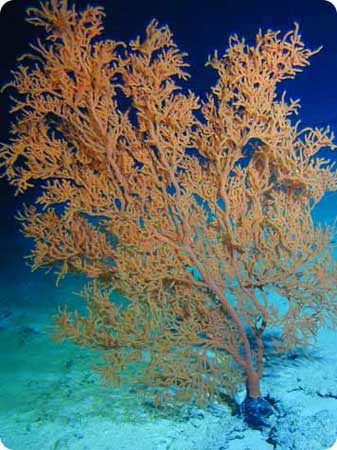When a black coral known as Leiopathes took root near the island of Oahu, the great pyramids of Giza glistened fresh and new in the Egyptian sun, their flanks encased in smooth limestone.
 Leiopathes sp., a deep water black coral has life spans in excess of 4200 years. Credit:Hawaii Undersea Research Laboratory, National Oceanographic Atmospheric Administration (NOAA) and Rob Dunbar.
Leiopathes sp., a deep water black coral has life spans in excess of 4200 years. Credit:Hawaii Undersea Research Laboratory, National Oceanographic Atmospheric Administration (NOAA) and Rob Dunbar. Over the millennia, the pyramids have crumbled a bit. Their casing stones were stripped away, and the desert encroached on their flanks. But the coral colonies have continued to grow, covering thousands of square feet of sea floor. Today, at an age of more than 4,250 years, they’re among the oldest living organisms on the planet.
Corals are made of millions of tiny polyps, which build up a hard skeleton. In the case of Leiopathes, the skeleton is shaped like a tree. The skeleton is black, while the living polyps are bright orange.
Over the last decade, researchers from Texas A&M University studied specimens of Leiopathes and other coral species around the islands of Oahu and Hawaii. They used radiocarbon dating techniques to measure the age of each specimen. The age doesn’t reflect the ages of the living polyps. Instead, it reveals when the first polyps began building the skeleton.
Scientists already knew that corals could live for several centuries. But the new research indicates that they can live much longer -- more than 42 centuries for a bed of Leiopathes, and more than 27 centuries for a bed of Gerardia.
But they may not last much longer. Commercial fishing has damaged some of the beds, and climate change may seal their fate. So like the pyramids, time may soon catch up to the corals of Hawaii.

